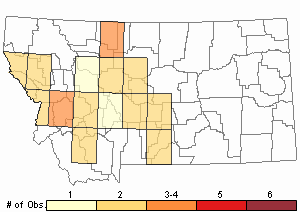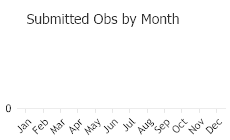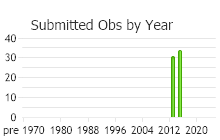View in other NatureServe Network Field Guides
NatureServe
Montana
Utah
Wyoming
Idaho
Wisconsin
British Columbia
South Carolina
Yukon
California
New York
White Pine Blister Rust - Cronartium ribicola
State Rank Reason (see State Rank above)
Species is not native to Montana and therefore no state rank is assigned (SNA).
General Description
White Pine Blister Rust is a fungal pathogen of five-needle pines native to China. It was introduced into North America around 1900. Since its introduction it has devastated Western White Pine (Pinus monticola), Sugar Pine (P. lambertiana), Limber Pine (P. flexilis) and Whitebark Pine (P. albicaulis) across the continent. In the Rocky Mountains, it has caused the decline of Whitebark pine which has contributed to the species continued candidate status for listing under the Endangered Species Act (US Department of the Interior 2016).
The life cycle of the fungus requires not only a susceptible pine host but also an intermediate host plant of the genus Ribes (currents and gooseberries). Within this alternate host it causes discoloration of the leaves but does not impact these plants beyond this. In pine hosts it initially causes discoloration in the needles and as the infection progresses, cankers on the branches and trunk. These cankers coincide with destruction of the cambium and if present around the circumference of the trunk, will cut off nutrients and cause the death of the tree (Maloy 2001).
Diagnostic Characteristics
Symptoms of White Pine Blister Rust vary by host species. In its intermediate Ribes host infection causes discoloration of leaves. Specifically, the lower surface of the leaves becomes pale and the fungus produces small orange fruiting bodies called uredinia which produce and release spores which reinfect the leaves. At the end of the season, short yellow-brown filaments grow called telium, which produce spores that disperse to pines (Geils et al. 2010).
In pines, initial infection manifests as discoloration of the needles late in the summer or autumn. Over several years the infection spreads into the cambium causing the characteristic cankers or blisters (aecia). These blisters appear yellow in the spring, eventually rupture and dry by the fall. As they have a relatively high sugar content, blisters are often chewed by rodents and expel sap (Maloy 2001).
Range Comments
Cronartium ribicola is native to Asia. After the introduction of Eastern White Pine (Pinus strobus) to Europe in the 1700's, White Pine Blister Rust spread to Russia and Finland and by 1900 was present across much of continental Europe. Infected nursery stock was sent to North America, introducing the fungus to both the east and west coasts during the early 1900's. From these points of introduction, the fungus has spread to the interior of North America and has been detected in all states except Utah, North Dakota, Nebraska, Kansas, Oklahoma, Texas, Arkansas, Louisiana, Mississippi, Alabama, South Carolina, and Florida (USDA Forest Service, Northern Research Station and Forest Health Protection 2019).
Observations in Montana Natural Heritage Program Database
Number of Observations: 65
(Click on the following maps and charts to see full sized version)
Map Help and Descriptions
Relative Density

Recency


 (Observations spanning multiple months or years are excluded from time charts)
(Observations spanning multiple months or years are excluded from time charts)
Habitat
This species can be found in any habitat where suitable host species and climate characteristics are present. In Montana, typically mid- high elevation pine forests.
Food Habits
Pine host species include all five-needle pines. Species native to Montana are: White Bark Pine (P. albicaulis), Western White Pine (P. monticola), and Limber Pine (P. flexilis). Alternate hosts are plants in the genera: Ribes, Castilleja, and Pediculari (Geils et al. 2010).
Ecology
Whitepine Blister Rust requires two hosts to complete its lifecycle, a five-needle pine and a Ribes shrub or other alternate host (Castillija spp., Pedicularis spp.). Pine trees are infected when spores enter through needle stomata. These spores germinate and the fungus grows through intercellular spaces of the bark toward the main stem. After several years, the fungus matures and produces the characteristic blisters that release aeciospores into the environment, typically in the spring. These spores are carried by the wind, and will infect alternate host species if deposited on the leaves, entering through stomates. As the summer progresses the fungus grows within the host leaves, and the rust produces reproductive structures called basidiospores in fall which if carried to a suitable pine host complete the cycle (Geils et al. 2010).
As the fungus is reliant on abiotic processes in the environment to distribute its spores, environmental factors can impact host suitability and distribution. Spores may be damaged by low-humidity so survival of spores is higher in damp areas. Cooler temperatures also favor survival of spores. As such local environments and microclimates may play a role in where rust is present and the severity of local outbreaks. In some areas that are generally too warm and dry for the fungus, the pathogen may be present in areas where local topography creates suitable climate conditions. Younger trees in the understory may be more susceptible due to the microclimate present within the forest (Van Arsdel et al. 2006).
Management
Many strategies have been employed to limit the damage of this fungus including mechanical and chemical treatments, with little effect on slowing its spread or restricting its distribution. There is no treatment that can be economically applied at the stand or forest level. Individual trees may be treated by pruning infected branches. Currently, efforts are underway to breed five-needle pines resistant to this pathogen for use in reforesting efforts in impacted areas (as reviewed in Geils et al. 2010).
For information and resources on plant pests and diseases see the USDA's Animal and Plant Health Inspection Service's
Plant Pests and Diseases ProfilesStewardship Responsibility
References
- Literature Cited AboveLegend:
 View Online Publication
View Online Publication Geils, B.W., K.E. Hummer, and R.S. Hunt. 2010. White pines, Ribes, and blister rust: a review and synthesis. Forest Pathology 40:147-185.
Geils, B.W., K.E. Hummer, and R.S. Hunt. 2010. White pines, Ribes, and blister rust: a review and synthesis. Forest Pathology 40:147-185. Maloy, O.C. 2001. White pine blister rust. Plant Health Progress 2(1):6 p.
Maloy, O.C. 2001. White pine blister rust. Plant Health Progress 2(1):6 p. US Department of the Interior. 2016. Endangered and threatened wildlife and plants: review of native species that are candidates for listing as endangered or threatened; annual notification of findings on resubmitted petitions; annual description of progress on listing actions. U.S. Fish and Wildlife Service Federal Register 81, No. 232. 27 p.
US Department of the Interior. 2016. Endangered and threatened wildlife and plants: review of native species that are candidates for listing as endangered or threatened; annual notification of findings on resubmitted petitions; annual description of progress on listing actions. U.S. Fish and Wildlife Service Federal Register 81, No. 232. 27 p. USDA Forest Service, Northern Research Station and Forest Health Protection. 2019. Alien Forest Pest Explorer - species map. Database last updated 25 March 2019. Accessed 9 September 2019. https://www.nrs.fs.fed.us/tools/afpe/maps/
USDA Forest Service, Northern Research Station and Forest Health Protection. 2019. Alien Forest Pest Explorer - species map. Database last updated 25 March 2019. Accessed 9 September 2019. https://www.nrs.fs.fed.us/tools/afpe/maps/ Van Arsdel, E.P., B.W. Geils, and P.J. Zambino. 2006. Epidemiology for hazard rating of white pine blister rust. In: Guyon, J. comp. Proceedings of the 53rd Western International Forest Disease Work Conference, August 26-29. Jackson, WY. Ogden, UT: U.S. Department of Agriculture, Forest Service, Intermountain Region. pp. 49-61.
Van Arsdel, E.P., B.W. Geils, and P.J. Zambino. 2006. Epidemiology for hazard rating of white pine blister rust. In: Guyon, J. comp. Proceedings of the 53rd Western International Forest Disease Work Conference, August 26-29. Jackson, WY. Ogden, UT: U.S. Department of Agriculture, Forest Service, Intermountain Region. pp. 49-61.
- Additional ReferencesLegend:
 View Online Publication
View Online Publication
Do you know of a citation we're missing? Dooley, Edith M. 2012. Mountain Pine Beetle outbreaks in high elevation Whitebark Pine forests: The effects of tree host species and Blister Rust infection severity on beetle productivity. M.S. Thesis. University of Montana. Missoula, MT.
Dooley, Edith M. 2012. Mountain Pine Beetle outbreaks in high elevation Whitebark Pine forests: The effects of tree host species and Blister Rust infection severity on beetle productivity. M.S. Thesis. University of Montana. Missoula, MT. Laufenberg, D.A. 2019. Biophysical gradients and performance of whitebark pine plantings in the Greater Yellowstone Ecosystem. M.Sc. Thesis. Bozeman, MT: Montana State University. 80 p.
Laufenberg, D.A. 2019. Biophysical gradients and performance of whitebark pine plantings in the Greater Yellowstone Ecosystem. M.Sc. Thesis. Bozeman, MT: Montana State University. 80 p. McCaughey, W.W. 1990. Biotic and microsite factors affecting Pinus albicaulis establishment and survival. Ph.D. Dissertation. Bozeman, MT: Montana State University. 78 p.
McCaughey, W.W. 1990. Biotic and microsite factors affecting Pinus albicaulis establishment and survival. Ph.D. Dissertation. Bozeman, MT: Montana State University. 78 p. Podruzny, S.R. 1999. Grizzly bear use of whitebark pine habitats in the Washburn Range. M.Sc. Thesis. Bozeman, MT: Montana State University. 60 p.
Podruzny, S.R. 1999. Grizzly bear use of whitebark pine habitats in the Washburn Range. M.Sc. Thesis. Bozeman, MT: Montana State University. 60 p.
- Web Search Engines for Articles on "White Pine Blister Rust"





